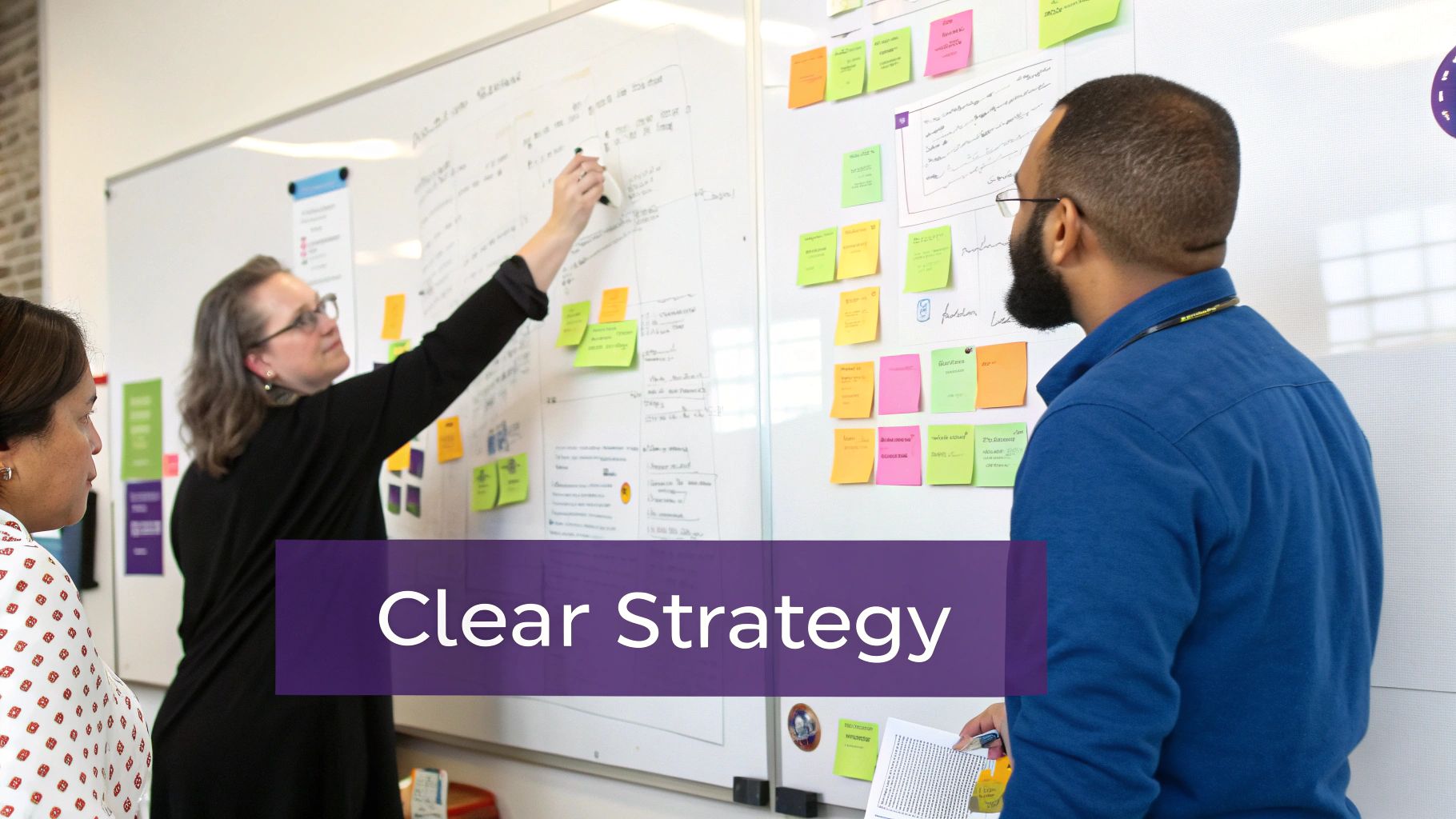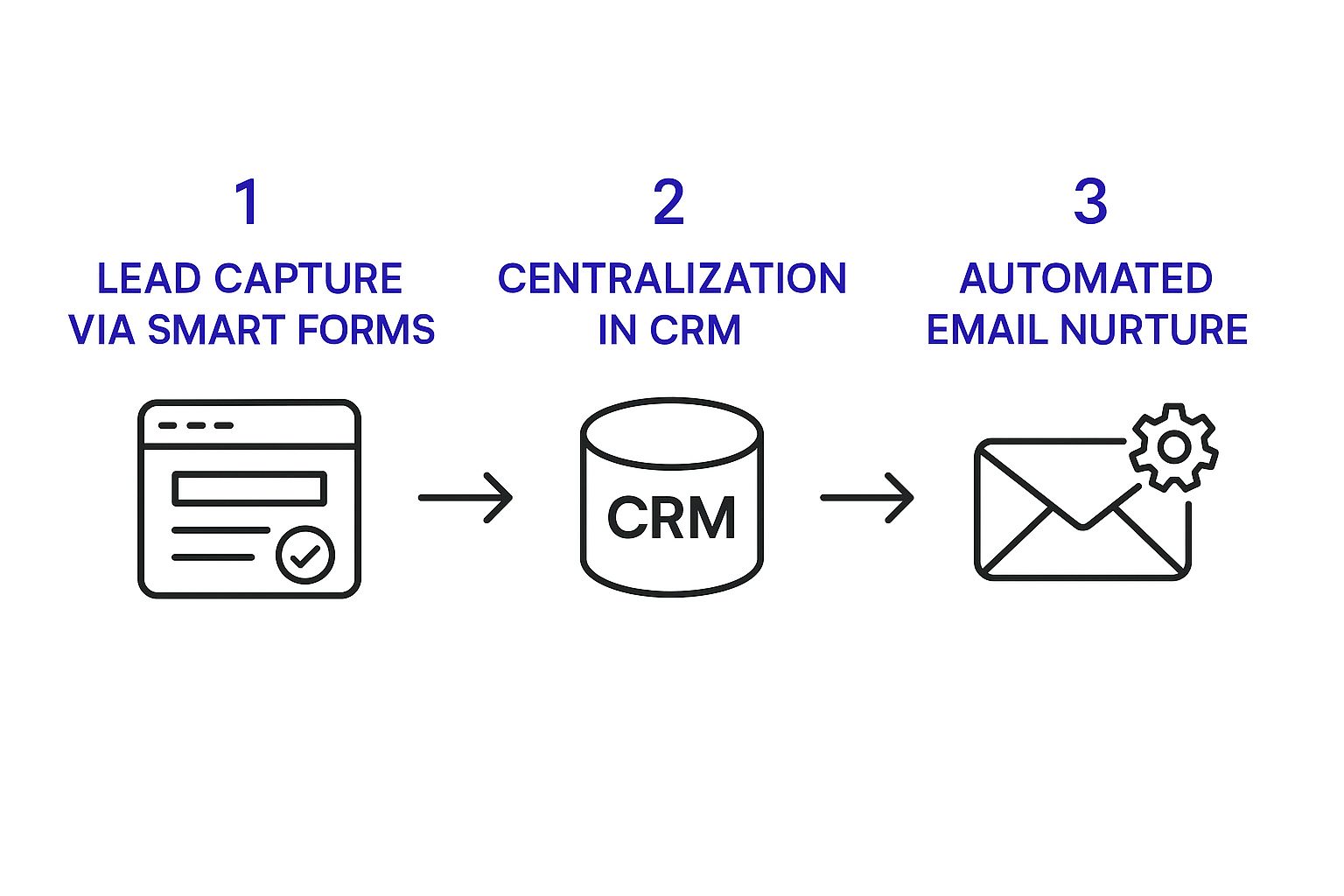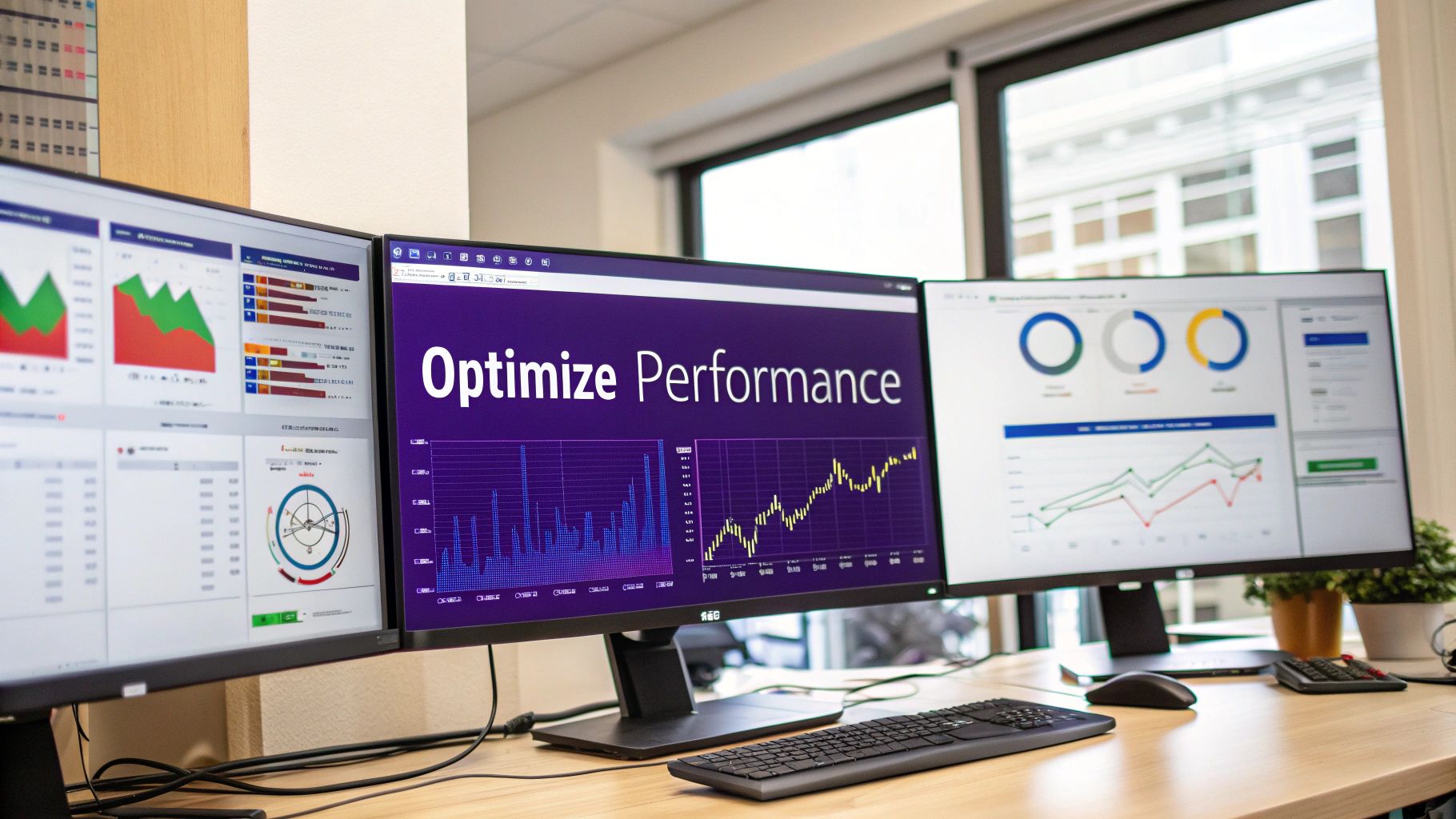Automating lead generation simply means using smart software to handle the repetitive, time-consuming tasks that go into finding and warming up potential customers. Think of it as building a system that brings interested prospects to your doorstep, rather than having your team knock on every single door manually. It’s about working smarter, not just harder, to keep your sales pipeline full.
This approach lets you scale your outreach efforts, engage with people around the clock, and free up your team to do what they do best: build relationships and close deals.

In today’s market, trying to keep up with manual lead generation is a losing battle. The pressure is on to grow faster and engage more effectively, making automation a core part of any serious growth strategy. It’s no longer a nice-to-have; it's essential for staying competitive.
Take a small B2B tech company for example. Their team can’t be online 24/7, but their potential customers are spread across different time zones. Automation steps in here, creating a huge advantage by nurturing leads with perfectly timed, relevant content long after the sales team has clocked out for the day.
To really see the difference, let’s break down the old way versus the new way.
This table gives a quick snapshot of how these two approaches stack up against each other.
The contrast is pretty stark. Automation isn't just a minor improvement; it fundamentally changes how you approach growth.
Let's be clear: automation isn't about replacing your sales team. It's about making them better.
By handling the grunt work—like data entry, initial follow-ups, and sorting through contacts—it gives your team back their most valuable asset: time. Instead of spending hours digging for needles in a haystack, they can jump straight into meaningful conversations with people who are genuinely interested and ready to talk.
This shift directly impacts your bottom line, turning your sales process from a high-effort, low-return grind into a well-oiled growth machine.
The ROI from automation isn't just a theory; the numbers speak for themselves. Businesses that put these systems in place see huge improvements in both the number and quality of their leads.
Automating lead generation doesn't just fill your pipeline—it fills it with the right people. Companies using this approach have reported up to a 451% increase in qualified leads. They also generate 50% more sales-ready leads at a 33% lower cost.
You can dig into more of these sales automation statistics at Utmost.agency. These figures build a powerful business case. It's not just about getting more done with fewer resources; it’s about focusing on the right activities that actually drive revenue. Investing in automation is an investment in a predictable, scalable sales engine that sets you up to win.

It’s tempting to dive headfirst into the latest automation tools, but hitting "go" without a clear strategy is just a fast track to a wasted budget. A powerful automation engine needs a solid blueprint. Before you even think about software, you have to get clear on who you're targeting, how they buy, and what you’re actually trying to achieve.
Think of it this way: your automation software is like a high-performance race car. It’s got all the power in the world, but without a skilled driver and a map of the track, you’re just going to spin your wheels. Your strategy is that map. It guides every single action your automation takes.
Your entire automation effort lives or dies by how well you know your audience. A vague idea of "our customer" just won't work here. You need a razor-sharp Ideal Customer Profile (ICP) so you aren't pouring time and money into leads who were never going to convert anyway.
Get your sales and marketing folks in a room (virtual or otherwise) and hash out the details. To build a truly useful ICP, you need to answer some tough questions:
A well-defined ICP is your North Star. It ensures every automated message and every targeted campaign is perfectly aligned.
Once you know who you're after, you need to understand how they actually interact with your brand. Mapping the customer journey isn't just a marketing exercise; it reveals the make-or-break moments where automation can have the biggest impact.
You don't need a complex, sprawling chart to start. A simple, linear path from awareness to purchase is all it takes to find the gold.
For a typical B2B SaaS company, that journey might look something like this:
Each one of those steps has trigger points that are perfect for automation—from instantly sending a follow-up email after an ebook download to flagging a high-intent lead for a sales rep.
It's a classic mistake to try and automate every single touchpoint. The real magic happens when you focus your efforts on those key conversion points where a timely, relevant message can nudge a lead over the finish line.
"Get more leads" isn't a strategy; it's a wish. To know if any of this is actually working, you need to set goals that are specific, measurable, achievable, relevant, and time-bound (SMART). This is the only way to prove ROI and make intelligent adjustments.
Ditch the vague desires and get specific with your targets.
These kinds of clear objectives give your strategy a purpose. They turn your automation from a collection of random tasks into a focused, growth-driving machine.
Walking into the automation software marketplace can feel like stepping into a labyrinth. There are endless options, and it's easy to get sidetracked. But here’s the secret: the goal isn’t to find one perfect, all-in-one tool. The real win comes from building an interconnected system—a tech stack—that’s perfectly tuned to your business.
Think of this stack as the engine driving your entire lead generation strategy. It’s what takes all those repetitive, manual tasks and turns them into a smooth, automated workflow.
At its heart, any solid lead generation stack has three key pillars. You can think of them as the brain, the voice, and the hands of your entire operation. Each piece has a distinct job, but they work together to capture, manage, and nurture leads from their very first click.
Your CRM: The Command Center: This is the non-negotiable center of your universe. A Customer Relationship Management (CRM) system acts as your central database, the single source of truth for every lead and customer interaction. It’s where you track contact details, communication history, and where someone is in the sales pipeline.
Marketing Automation: The Nurturing Engine: This is where your communication strategy actually comes to life. A platform like Mailchimp or HubSpot executes your email sequences, segments your audience, and delivers personalized messages at scale. It’s the tool that ensures the right message finds the right person at just the right moment.
Lead Capture Tools: The Digital Handshake: These are your front-line soldiers, gathering prospect information at every opportunity. This can be anything from a smart form on your landing page, a pop-up offering a lead magnet, or an AI-powered chatbot from a tool like Tidio that engages visitors 24/7.
The magic truly happens when these three components talk to each other. A prospect fills out a form (lead capture), their data instantly populates a profile in your CRM, and a personalized email welcome sequence is automatically triggered (marketing automation). It's a completely hands-off and seamless experience.
Don't get bogged down in an endless feature-by-feature comparison. Instead, use a simple framework to make your decision. Your budget, the size of your team, and the systems you already use are the most important factors.
Don’t just choose tools; build a system. The most expensive software is useless if it doesn't integrate with your CRM or if your team finds it too complex to use. Focus on how the pieces fit together.
Let’s look at a real-world scenario. A small B2B consulting firm doesn’t need a massive enterprise platform. They could easily thrive with a flexible CRM like HubSpot's free tier, connect it to a user-friendly email tool like Mailchimp, and use a simple Tidio chatbot for their website.
On the other hand, a fast-growing SaaS company needs something more powerful. They might build their stack around Salesforce as their CRM, use a robust automation platform like Marketo for complex nurture flows, and implement an advanced tool like Intercom for its sophisticated chatbot and lead qualification features.
The AI built into these modern systems is what really moves the needle. In fact, companies that lean into AI-driven automation see over a 50% increase in sales-ready leads and cut their acquisition costs by up to 60%. A big part of this comes from AI's ability to perform real-time, dynamic lead scoring.
If you want to dive deeper, you can discover more about how AI is revolutionizing lead generation with involve.me. This kind of intelligent sorting ensures your sales team is always focusing their energy on the leads most likely to convert.
Okay, you've got your strategy mapped out and your tools are all talking to each other. Now for the fun part: building the engine that will actually run your lead generation on autopilot.
An automated workflow is really just a sequence of actions that kicks off when a lead does something specific. Think of it as a digital path you create, guiding potential customers from that first flicker of interest all the way to being ready for a sales call. And the best part? It all happens without you having to manually trigger every single step.
The secret to making this work isn't just about automation; it's about making it feel human. The goal is to deliver the right message at the right time, making you a helpful guide, not a robotic salesperson. Let's walk through three powerful workflows you can set up right away.

As you can see, a good workflow creates a clean, direct line from a prospect's initial action right through to ongoing engagement, connecting your lead capture forms, CRM, and nurturing sequences into one cohesive system.
This is your bread and butter—the workflow that most businesses start with, and for good reason. It springs into action the second someone becomes a lead, maybe by downloading an ebook or signing up for your newsletter. The entire point here is to build trust and educate them, not shove a sales pitch down their throat.
Let's imagine someone just downloaded your "Ultimate Guide to Project Management." Here’s what a smart, non-pushy nurturing sequence could look like:
Notice the pattern? Value, value, value, then a subtle pitch. You’ve earned their attention by being genuinely helpful.
Let's be real: not all leads are the same. A person who downloaded an introductory guide is miles away from someone who's visited your pricing page three times this week. This next workflow is all about automatically spotting the truly motivated buyers and getting them to your sales team, fast.
The magic behind this is lead scoring. You simply assign points to different actions a lead takes.
The workflow itself is incredibly straightforward. When a lead's score hits a certain number (say, 50 points), the automation instantly creates a task in your CRM, assigns the lead to a sales rep, and can even shoot a real-time notification to your team's Slack channel. This single change can slash your sales cycle time because you’re catching buyers at the peak of their interest.
What about all those leads who showed interest months ago but then went silent? Don't just let them gather digital dust. A re-engagement workflow is designed to bring these dormant contacts back from the dead. This sequence usually targets anyone who hasn't opened an email or visited your site in over 90 days.
Here’s a simple, three-part re-engagement play:
As you build out these core systems, don't forget about channel-specific automations. For instance, learning how to automate LinkedIn posts can keep your brand top-of-mind where your B2B prospects are spending their time. Ultimately, these workflows are the heart of your automation strategy, doing the heavy lifting to turn passive interest into active sales conversations.

Getting your automated workflows live is a huge milestone, but it's really just the starting line. Your automation system isn't a "set it and forget it" machine. Think of it more like a high-performance engine that needs constant tuning to keep it running at its best.
If you just let it run on its own, you're almost certainly leaving growth on the table. The real magic happens when you shift from just running workflows to actively optimizing them based on what the data is telling you. This means focusing on the numbers that actually drive growth, not just vanity metrics.
To get this right, you have to track the right essential lead generation KPIs. Forget things like email open rates for a moment. Instead, you need to zero in on the data points that draw a straight line from your automation efforts to actual revenue.
Here are the core metrics I always have on my dashboard:
Watching these specific numbers gives you an objective, unfiltered view of what's working and what’s a waste of resources.
Treat every part of your automated workflow as a hypothesis waiting to be tested. A small tweak to an email subject line or the timing of a follow-up can have a surprisingly large impact on your conversion rates.
Your data tells you what is happening. Your sales team can tell you why. This is a crucial distinction.
One of the most powerful optimizations you can make has nothing to do with software—it’s about creating a tight feedback loop between marketing automation and sales. Your sales reps are on the front lines every single day, talking to the very leads your system is nurturing. Their insights are pure gold.
For example, a sales rep might tell you that leads who downloaded a particular case study are closing 30% faster than any other group. That's not just a nice-to-know tidbit; it's a critical piece of intelligence.
This is the kind of feedback that allows you to immediately refine your lead scoring model, tweak your nurture paths to push that high-performing case study earlier, and build a much smarter engine for automating lead generation.
This cycle is everything: measure the data, test your assumptions, get qualitative feedback, and repeat. That’s how you turn a good automation setup into a world-class growth machine.
Even with a solid plan in hand, it’s completely normal to have some questions before diving into lead generation automation. I’ve seen it time and time again—people wonder if the tech will come across as robotic or if it’s truly worth the time and money for their unique business.
Let's clear the air and tackle some of the most common reservations I hear.
One of the biggest worries is losing that all-important "human touch." But here’s the thing: good automation isn’t about replacing genuine conversations. It’s about taking over the repetitive, time-consuming tasks so your team has more time for those meaningful interactions. A well-built system warms up leads with helpful content, freeing up your sales reps to step in when a lead is actually ready to talk.
Another myth is that automation is just for the big players with deep pockets. That couldn't be further from the truth. Today's tools are incredibly scalable and affordable, allowing even small businesses to engage prospects around the clock—something that’s simply impossible to do manually.
Honestly, getting started is way more straightforward than most people imagine. The majority of modern platforms, like HubSpot or ActiveCampaign, have intuitive, drag-and-drop builders for creating workflows. You don’t need to be a coding wizard to build something effective.
You can start with a simple sequence, like an email follow-up for anyone who downloads an ebook, and then build out more complex systems as you get the hang of it.
My advice is always to start small. Pick one single process to automate and absolutely nail it. Once you see the results and get a clear ROI, it’s much easier to make the case for expanding your efforts.
This space is always changing, with AI becoming a much bigger piece of the puzzle. For instance, AI-powered chatbots are now the go-to for many customers—in fact, 62% of consumers prefer them for 24/7 engagement.
Another major trend, especially in B2B, is account-based marketing (ABM). This is where you use automation to run highly personalized campaigns targeting specific high-value companies. Getting this right can lead to a 33% increase in average contract value, which is a massive win for any sales team. You can discover more 2025 lead generation trends here.
Ready to turn untouched leads into scheduled meetings? Upcraft's conversational AI agents are designed to re-engage dormant opportunities and convert leads 5x more effectively than traditional methods. See how Upcraft can fill your sales pipeline at upcraft.ai.
Enter your contact information and Archer will start a conversation with you via text message.